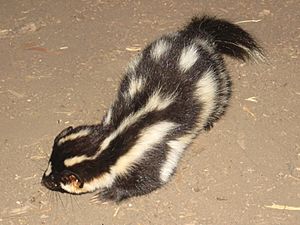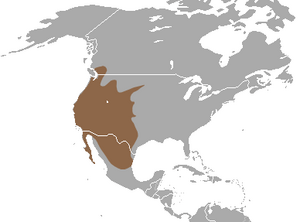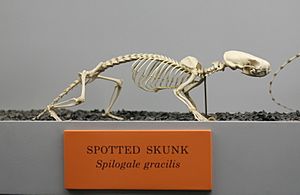Western spotted skunk facts for kids
Quick facts for kids Western spotted skunk |
|
|---|---|
 |
|
| Spilogale gracilis | |
 |
|
| Spilogale gracilis amphialus | |
| Conservation status | |
| Scientific classification | |
| Genus: |
Spilogale
|
| Species: |
gracilis
|
 |
|
|
Western spotted skunk range
|
|
The western spotted skunk (Spilogale gracilis) is a small skunk found in western North America. It is known for its unique black and white spotted pattern.
Contents
What Does a Western Spotted Skunk Look Like?
The western spotted skunk is smaller than the more common striped skunk. It measures about 35 to 45 centimeters (14 to 18 inches) long. Males are heavier than females, weighing between 336 to 734 grams (12 to 26 ounces). Females weigh 227 to 482 grams (8 to 17 ounces).
This skunk has bold black and creamy white stripes. It has three long stripes on each side of its front body. Three vertical stripes are on its back end. One pair of stripes runs along its spine. Another pair goes over its shoulders and onto its face. The third pair starts lower on the shoulders and curves down.
Sometimes, the black fur can look reddish or brown. The white areas might appear gray or yellow. Scientists are still learning why these color changes happen.
The skunk has short, round ears. A white spot is between its eyes. There is also a white patch below each ear. Its tail is long and bushy, about 10 to 16 centimeters (4 to 6 inches) long. The tail is mostly black with a white tip. Its front claws are longer and more curved than its back claws. This helps them dig.
How Do Skunks Defend Themselves?
Like other skunks, the western spotted skunk has special glands near its tail. These glands can spray a strong-smelling liquid called musk. The musk is a defense against predators. It smells very strong and can be quite pungent.
Western spotted skunk musk is different from striped skunk musk. It has unique chemicals that give it a different smell. However, it does not spread as far as the musk from a striped skunk.
Where Do Western Spotted Skunks Live?
You can find the western spotted skunk across the western United States. They also live in northern Mexico and southwestern British Columbia. They like different kinds of places. These include mixed woodlands, open fields, and farmlands.
Their favorite spots depend on what is available nearby. In places like Idaho and Washington, they prefer areas near rivers with thick bushes. These bushes offer good hiding and foraging spots. In eastern Oregon or northern Mexico, they often live near cliffs and canyons.
Behavior and Diet of the Western Spotted Skunk
Western spotted skunks are active at night. They are omnivores, meaning they eat both plants and animals. Their diet includes insects like beetles and grasshoppers. They also eat scorpions and small animals. These small animals can be mice, voles, small birds, or even rabbit babies.
They also enjoy roots, grains, fruits, and berries. Sometimes, they eat eggs or dead animals. Skunks can help control pests in areas where they live. They have even been seen eating scorpions in the southwest!
Who Hunts Western Spotted Skunks?
Golden eagles are one of the few animals that hunt western spotted skunks. During the day, skunks rest in their dens. They usually live alone. However, sometimes two or three female skunks might share a burrow. Males stay by themselves during the winter.
Western spotted skunks try to gain weight before winter. They do not truly hibernate. But they can sleep for several weeks during the coldest months. During this time, females might gather in groups. These groups can be as large as 20 skunks.
How Do Skunks Warn Predators?
When a western spotted skunk feels threatened, it performs a special warning dance. It stamps its front feet. Then, it raises its back legs and tail high in the air. This shows off its bright warning colors.
They can spray musk while standing on their front legs. But they usually spray with all four feet on the ground. They bend their body so both their head and tail face the attacker.
Reproduction and Life Cycle
Western spotted skunks become ready to have babies faster than other skunk species. They usually breed in September. This is when females are ready to mate. Both males and females can still breed for several months if they don't mate early.
After mating, the baby skunk starts to grow. But then it goes into a dormant period for several months. This means it stops growing for a while. It then attaches to the mother's womb around April.
Including this resting period, pregnancy lasts about 230 to 250 days. Two to five baby skunks, called kits, are born in May. When they are born, kits are blind and have very little hair. They weigh about 11 grams (0.4 ounces). Young females can have their own babies when they are about 4 or 5 months old. In zoos, western spotted skunks have lived for almost ten years.
Skunk Family and Names
The western spotted skunk was first described in 1890 by a scientist named Clinton Hart Merriam. Its scientific name, gracilis, means "slender" in Latin.
Scientists still discuss if the western spotted skunk is a separate species from the eastern spotted skunk. They look at differences in their bodies, how they breed, and their DNA. Many believe they are different species.
There are seven recognized types, or subspecies, of S. gracilis. These were found in the late 1800s and early 1900s. Each subspecies lives in a specific part of the western skunk's territory. They are adapted to the climate and environment of their area.
Subspecies of Western Spotted Skunk
Here are the seven recognized subspecies:
- S. g. amphialus Dickey, 1929 — Channel Islands spotted skunk (Channel Islands of California)
- S. g. gracilis Merriam, 1890 — from southeastern Washington to western Oklahoma
- S. g. latifrons Merriam, 1890 — southwestern British Columbia to western Oregon
- S. g. leucoparia Merriam, 1890 — southern Arizona, New Mexico, and Texas, and northern Mexico
- S. g. lucasana Merriam, 1890 — southern Baja California
- S. g. martirensis Elliot, 1903 — northern and central Baja California
- S. g. phenax Merriam, 1890 — California
Western Spotted Skunks and People
Some people keep skunks as pets. They can even be trained to use a litter box, much like a cat.
However, western spotted skunks can sometimes cause problems in rural areas. They might make dens on private property or in attics. They also like to steal eggs from farms.
The western spotted skunk is a species that adapts well to human areas. It is not considered endangered or threatened.
See also
 In Spanish: Mofeta moteada para niños
In Spanish: Mofeta moteada para niños



